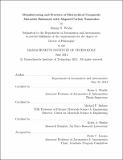Manufacturing and fracture of hierarchical composite materials enhanced with aligned carbon nanotubes
Author(s)
Wicks, Sunny S
DownloadFull printable version (32.06Mb)
Other Contributors
Massachusetts Institute of Technology. Department of Aeronautics and Astronautics.
Advisor
Brian L. Wardle.
Terms of use
Metadata
Show full item recordAbstract
Hierarchical advanced composite structures comprised of both nano- and micro-scale fibers are currently being studied as next-generation materials for multifunctional aerospace applications. Carbon nanotubes (CNTs) are an attractive reinforcing fiber for aerospace composites due to their scale and superior specific stiffness and strength, as well as their potential to enhance multifunctional properties. Nano-scale fibers can address current challenges in composites such as relatively weak through-thickness properties that occur due to matrix-rich regions, including those found at interlaminar ply interfaces, that are prone to delamination and lead to overall reductions in mechanical properties. Existing technologies such as stitching, z-pinning, and braiding provide through-thickness reinforcement; however, these improvements come with simultaneous reductions in in-plane properties. CNTs provide an alternative fiber reinforcement, though currently the literature reveals that laminate mechanical property enhancements are lower than expected. Investigations into how CNTs affect laminate properties have stalled due to difficulties with producing quality laminates and controlling CNT orientation and dispersion. In this work, manufacturing routes of a nano-engineered composite are developed to provide consistent control over laminate quality while placing aligned CNTs (A-CNTs) in the polymer matrix in the interlaminar and intralaminar regions. Manufacturing techniques are developed for growing aligned CNTs on a three-dimensional woven microfiber substrate and infiltrating the fuzzy fiber plies with polymer to realize the Fuzzy Fiber Reinforced Plastics (FFRP) architecture. These FFRP laminates show < 1% void fraction for a viscous marine epoxy system via hand lay-up and effectively void free (<< 1%) laminates for an aerospace epoxy system via infusion. The influence of the A-CNTs on manufacturability is quantified by assessing permeability and compressibility of the fuzzy fiber plies. Less than an order of magnitude decrease in permeability independent of CNT loading is observed (up to 3.6% volume fraction), demonstrating compatibility of the fuzzy fiber plies with both polymer matrices and both manufacturing routes. By contrast, fuzzy fiber ply compressibility increases linearly with CNT loading such that target composite volume fractions of - 50% mnicrofiber volume fraction can only be achieved with added external pressure in ranges typically available in composite production. The mechanisms of Mode I fracture toughness enhancement in FFRP laminates are elucidated experimentally by varying the type of epoxy and length of A-CNTs. Reinforcement effectiveness is found to vary from reduced initiation toughness to 100% increase in steady-state fracture toughness, depending upon the interlaminar fracture mechanisms. Toughness enhancement is less than expected based on idealized fiber pullout models, and is attributed to multiple and competing modes. Fractography reveals toughening mechanisms for both aerospace and marine epoxy laminates at several length scales, from the pull-out of A-CNTs to microfiber tow breakage. The toughening behavior and magnitude of steady-state toughness improvement is found to be highly dependent on the type of epoxy. In the more brittle aerospace epoxy system, modest improvement (~ 33%) in steady-state toughness with long (~ 19 microns) A-CNTs occurs because the cohesive interlaminar matrix failure mode around woven tow features is unchanged and toughening only occurs via increased fracture surface area through CNT pullout and rough epoxy fracture. The tougher marine epoxy allows much larger (up to 100%) steady-state toughness enhancement with A-CNTs by significantly adding instances of microfiber breakage and pullout along with CNT pullout from the epoxy. Varying the CNT length begins to reveal how the geometrical (re)arrangement of microfibers through tow swelling and changes in woven ply nesting affect the crack propagation path and subsequent interlaminar toughness. Fracture of A-CNT polymer nanocomposites isolates CNT-polymer effects from the microfibers and shows no increase in initiation toughness from the A-CNTs, but does confirm the role of CNTs in increasing fracture surface area post crack initiation, i.e., steady-state toughening. This work establishes the dependence of fracture toughness on A-CNT length and polymer type for the FFRP architecture. Future work includes quantifying the contribution of CNT pullout from the matrix on the laminate fracture behavior via modified standard tests for fracture initiation and toughness. Preliminary multifunctional investigations of the FFRP architecture indicate several other promising directions of future work, including damage sensing. Based on new understanding in this work on boh manufacturing and reinforcing mechanisms at work in FFRPs, mechanical and multifunctional enhancement of aerospace composites, particularly carbon fiber FFRP, are enabled.
Description
Thesis: Ph. D., Massachusetts Institute of Technology, Department of Aeronautics and Astronautics, 2014. Cataloged from PDF version of thesis. Includes bibliographical references (pages 155-165).
Date issued
2014Department
Massachusetts Institute of Technology. Department of Aeronautics and AstronauticsPublisher
Massachusetts Institute of Technology
Keywords
Aeronautics and Astronautics.